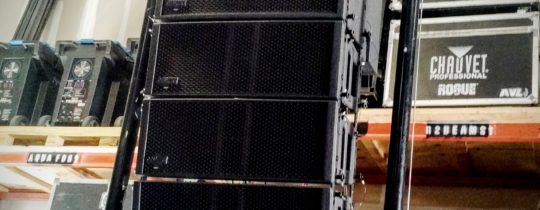First Look – EAW RADIUS Speaker Line

Hands On – Yamaha RIVAGE PM10 (Finale)
October 11, 2016
First Look – Mackie AXIS System Digital Mixer
October 11, 2016I received a call this week from our FL Rep for LOUD Technologies (EAW, Martin Audio, Mackie, and others) to let me EAW and Mackie would be making a stop in Jacksonville to demo some new products that might prove interesting to me. I attended the demo. He was right. Mackie was showing their latest entry into the world of full-scale professional digital audio mixing systems. They call it AXIS. More on that in another post.
EAW rolled out a new speaker line, called RADIUS. The center piece of the line (pun unintended) is a compact 3-way line array module, the RSX208L. The 208L (and indeed, every speaker in the RADIUS line) is wood enclosed, self-powered, has in-built DSP that is addressable wirelessly, and has both analog and DANTE digital in and out to provide audio and wired network connectivity. The 208L module houses (believe it or not) 2×8” drivers and 2×1” exit HF compression drivers. Like other similar boxes, both 8” speakers contribute to low frequency output, while one 8” handles mids. The stacked HF drivers (in the center of the box) provide proper line array spacing for seamless box to box to box configuration. Every full-range speaker in the line-up benefits from EAW’s trademarked “Focus” processing as well as “DynO” overload protection. Power inside each cabinet is Class D with 1000W or more available.
The balance of the RADIUS line is comprised of two subwoofer models; a single 18” and single 12” version. The single 18 is easily setup in cardioid arrays with a rear panel button push. There are also two 2-way standard boxes; one with 12” & Horn and the other with 8” and horn. There is a 12” coax monitor still to come.
Before getting back to the details on the line array, let me tell you what blew me away in the demo. The little 8” 2-way, model RSX89 (or 86, depending on coverage option). That puppy could sing! For pop music or any vocal-forward application, I would recommend that little guy without hesitation. I am not sure the price point, but it should be quite affordable, since the 3-way line array modules should be on the streets at under $2500 per module by all estimates. Seriously, you could have told me the 8” was a coax and I would have believed you. Hey EAW, if you see this, consider manufacturing a stage monitor version of the RSX86/89 – maybe with a 90×90 horn option.
OK, so EAW has added another self-powered compact line array option to your current list of choices, so what? It probably sounds good, right? Yup. Probably can play really loud…yup. Light weight with easy to use integral rigging, I suppose. Yup, yup. You mentioned Dante in and out, right – ‘cause that’s cool…Yup again. So what is so special?
Glad you finally asked. EAW calls it “OptiLogic” and EAWMosaic”.
Each RSX208L 12×120 degree module has IR sensors and tilt sensors built-in, so that it knows how many boxes are in the array, and the tilt angle of each component. That’s the OptiLogic part. OptiMosiac is a proprietary prediction software app that allows you to enter the details of your venue, including desired SPL, and then it tells you how many boxes to hang, and where. It is infinitely adjustable to meet your preferences for coverage, etc. Of course, as already mentioned, Dante connectivity is standard for transmission of audio and control.
Here is the really cool part. You (very quickly) setup your system in the software. Hang your arrays based on the model, engage the physically installed units so they can verify their array setup and hang angles, and then transmit the DSP settings to each array. EAW provides four separate voicing options that are based on real world touring FOH engineers’ preferred sounds. You can choose the voicing you like – or tweak it to make your own. If you are considering this setup for a rental or small touring rig, you should be very excited right now. Of course, the system is also very clean and tidy, so will be right at home in many, many installation scenarios as well. And remember, the price point is similar to other manufacturers’ offerings for 2-way powered arrays that do not include Dante connectivity or predictive modeling and wireless control.
One more cool feature; the app allows you to test EACH driver in each box of the array independently…from the ground, using your iPad. Cool? I know, right?!?
And THAT is what is so special. Find out more at the EAW web site.
I think EAW has a winner in the RADIUS line. I look forward to spec’ing these.
#EAWRadius #EAW

